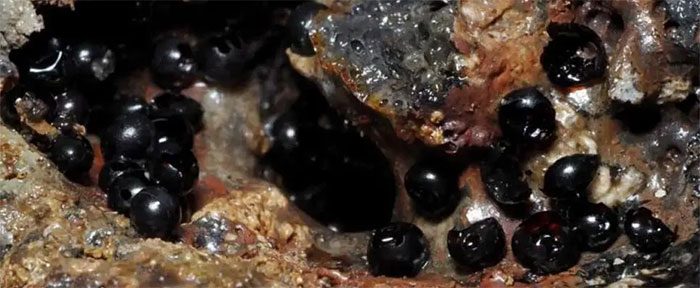A mysterious cluster of black eggs has been brought to the surface by deep-sea exploration equipment, containing the embryos of an unknown organism never before recorded by science.
According to Science Alert, the cluster of strange eggs was discovered by an ROV (remotely operated vehicle) operating in the depths of the Northwest Pacific Ocean, reaching depths of up to 6,200 meters.
Marine researcher Yasunori Kano from the University of Tokyo (Japan) – who operated the ROV – described them as small, enigmatic black spheres.

Strange eggs discovered at a depth of 6,200m in the Pacific Ocean – (Photo: UNIVERSITY OF TOKYO)
Intrigued, they decided to retrieve some of the black spheres. Upon surfacing, most of them were found to be attached to rocks, torn and empty. Only four remained intact and were sent to invertebrate biologists Keiichi Kakui and Aoi Tsuyuki at Hokkaido University (Japan).
Examination results revealed that they were small leathery capsules, approximately 3 mm in diameter, with each egg containing 3-7 developing flatworms. When the eggs were opened, a cloudy white liquid – possibly the yolk – flowed out along with the embryos of the flatworms.
By sampling the DNA of the flatworm embryos, researchers discovered that they belong to species previously unknown to science, but are genetically closely related to two subspecies that inhabit shallower waters.
All known flatworms are hermaphrodites, meaning they possess both male and female gametes. Species living in shallower waters still reproduce sexually by laying egg capsules that attach to substrates like rocks.
However, to date, scientists know very little about free-living flatworm species in deep water, let alone their reproductive methods. The deepest confirmed flatworm species was found at a depth of 3,232 meters.
At a depth of 6,200 meters, whatever species these may be, they represent a form of extreme life that is astonishing, providing unprecedented insights into how life can exist on Earth – and possibly on other worlds.
It is possible that species from shallower waters have gradually encroached into the deep sea, but it remains unclear why they have evolved in this manner.
The research on these mysterious eggs has recently been published in the scientific journal Biology Letters.


















































